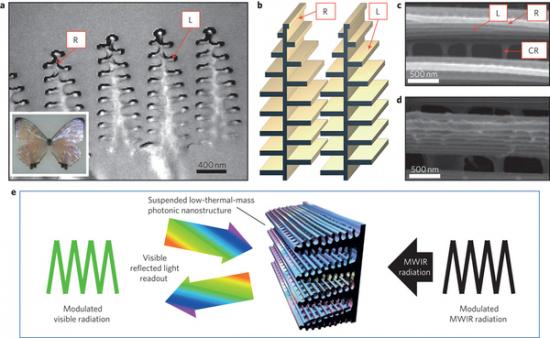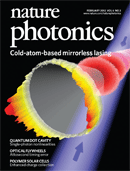导读:由于红外热成像可将物体自身散发的热能可视化,因而其在工业、军事和医学方面具有广泛应用。Radislav Potyrailo和同事设计出一种仿生传感器,这或将有助于设计热成像传感器。

科学家近日通过研究闪蝶这种具有500万年历史的生物,从其多彩变化的翅膀中找到灵感,设计出一种灵敏的红外传感器,本周出版的《自然—光子学》详细报告了这项成果,这或将有助于设计热成像传感器。
由于红外热成像可将物体自身散发的热能可视化,因而其在工业、军事和医学方面具有广泛应用。Radislav Potyrailo和同事设计出一种仿生传感器,具备比现有红外检测器体积更小、检测速度更快、灵敏度更高的优势,而且其对热量控制没有要求,也不需要复杂的精密加工技术。在这项设计实验中,他们将较新的碳纳米管技术与闪蝶翅膀的多彩变化这一特点相结合,经过实验,科学家发现当红外线辐射到翅膀上时,填满空气的光纳米结构的热量将增加并扩散,从而使得翅膀颜色发生变化。此外他们还发现,翅膀上的碳纳米管涂抹量增大,翅膀的可吸收辐射量也会随之增加,从而提高传感器的灵敏性。

Towards high-speed imaging of infrared photons with bio-inspired nanoarchitectures
Andrew D. Pris, Yogen Utturkar, Cheryl Surman, William G. Morris, Alexey Vert, Sergiy Zalyubovskiy, Tao Deng, Helen T. Ghiradella & Radislav A. Potyrailo
Existing infrared detectors rely on complex microfabrication and thermal management methods. Here, we report an attractive platform of low-thermal-mass resonators inspired by the architectures of iridescent Morpho butterfly scales. In these resonators, the optical cavity is modulated by its thermal expansion and refractive index change, resulting in ‘wavelength conversion’ of mid-wave infrared (3–8 µm) radiation into visible iridescence changes. By doping Morpho butterfly scales with single-walled carbon nanotubes, we achieved mid-wave infrared detection with 18–62 mK noise-equivalent temperature difference and 35–40 Hz heat-sink-free response speed. The nanoscale pitch and the extremely small thermal mass of individual ‘pixels’ promise significant improvements over existing detectors. Computational analysis explains the origin of this thermal response and guides future conceptually new bio-inspired thermal imaging sensor designs.
文献链接:https://www.nature.com/nphoton/journal/vaop/ncurrent/full/nphoton.2011.355.html








